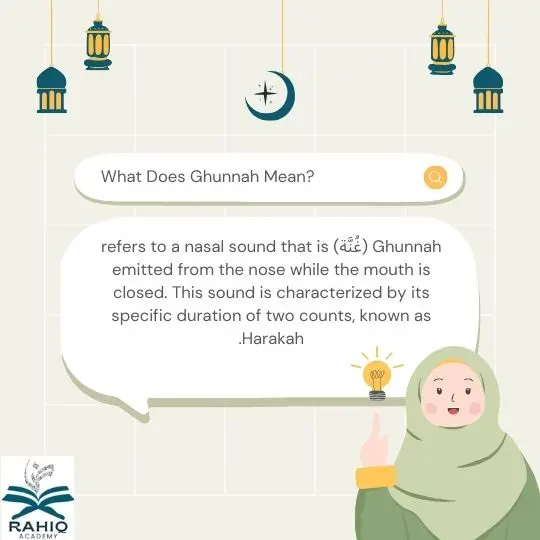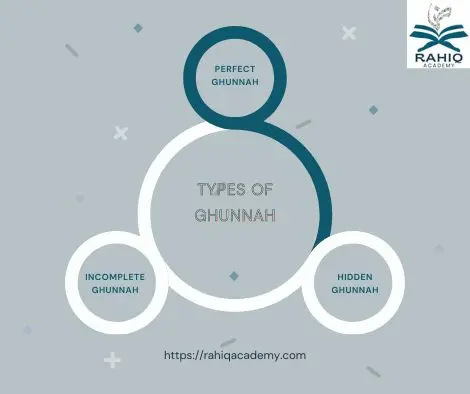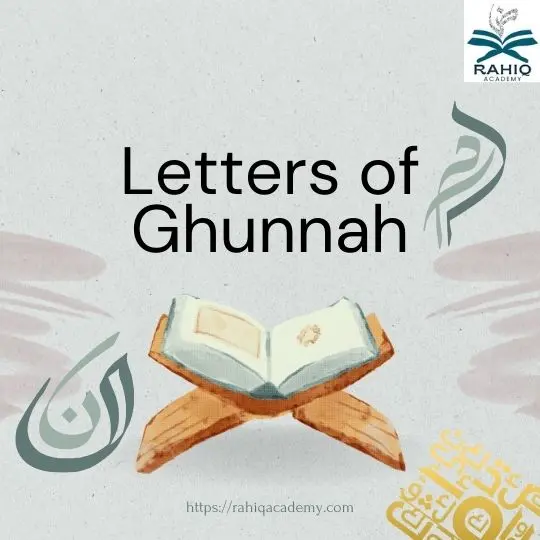The science of Tajweed, which governs the correct pronunciation of the Quran, is essential for preserving its divine message. Among its key components is the concept of Ghunnah (غُنَّة), a unique nasal sound that is crucial for maintaining the beauty and precision of Quranic recitation. In this comprehensive guide, we will explore letters of Ghunnah, the meaning, application, types, and examples of Ghunnah, helping readers gain a deeper understanding of this important aspect of Tajweed.
What Does Ghunnah Mean?

Ghunnah (غُنَّة) refers to a nasal sound that is emitted from the nose while the mouth is closed. This sound is characterized by its specific duration of two counts, known as Harakah. The term Ghunnah originates from the Arabic root غنّ, which means to hum or produce a nasal tone. In the context of Tajweed, Ghunnah is associated with the letters Noon (ن) and Meem (م) when they carry a Shaddah (ّ) or appear under certain rules such as Ikhfaa’, Idghaam, and Iqlaab.
The correct application of Ghunnah is essential for maintaining the integrity of Quranic recitation. It ensures that the pronunciation remains true to the divine revelation, as Allah (SWT) commands in the Quran:
وَرَتِّلِ الْقُرْآنَ تَرْتِيلًا
“And recite the Quran with measured recitation”
(Surah Al-Muzzammil, 73:4)
This verse emphasizes the importance of reciting the Quran with precision and care, a responsibility that requires adherence to Tajweed rules, including the proper use of Ghunnah.
How to Do Ghunnah?
To perform Ghunnah correctly, one must understand both the technique and the conditions under which it is applied. Below is a step-by-step guide:
Nasal Resonance
The sound of Ghunnah must resonate through the nasal cavity. Close your mouth and ensure that the air flows through the nose only. You can test this by placing your fingers on the bridge of your nose; you should feel a slight vibration.
Correct Letters
Ghunnah applies to the letters Noon (ن) and Meem (م) when they are:
- Followed by a Shaddah (ّ), as in “إِنَّ” (Indeed) and “ثُمَّ” (Then).
- Found in specific Tajweed rules such as Ikhfaa’ (hiding), Idghaam (merging), and Iqlaab (changing).
Duration
The Ghunnah sound should be maintained for two counts, or Harakah. This requires the reciter to hold the nasal sound for the time it takes to say “one-two” in a steady rhythm.
Practice Techniques
Regular practice is crucial for mastering Ghunnah. Start with simple phrases and gradually move to more complex ones, ensuring that you maintain the nasal sound consistently for the correct duration.
Avoid Common Mistakes
Ensure that the Ghunnah sound is neither too nasal nor too faint. It should be a smooth, continuous sound, without any abrupt stops or excessive prolongation.
What Are the Letters of Ghunnah?
The letters associated with Ghunnah are Noon (ن) and Meem (م). These letters are subject to Ghunnah in the following scenarios:
Noon Mushaddad (نّ)
When the letter Noon carries a Shaddah, as in the word “إِنَّ” (Indeed, Surah Al-Kawthar, 108:1). The Ghunnah sound is strong and should be held for two counts.
Meem Mushaddad (مّ)
When the letter Meem carries a Shaddah, as in the word “ثُمَّ” (Then, Surah Al-Baqarah, 2:199). The Ghunnah sound is pronounced for two counts.
Ikhfaa’ (إخفاء)
This rule applies when Noon Saakinah (نْ) or Tanween (ــًــٍــٌ) is followed by one of the 15 letters of Ikhfaa’. For example:
مِن شَرِّ الْوَسْوَاسِ الْخَنَّاسِ
“From the evil of the whisperer who withdraws”
(Surah An-Nas, 114:4)
The Noon Saakinah (نْ) in “مِن” is followed by the letter Sheen (ش), requiring the application of Ghunnah.
Idghaam with Ghunnah (إدغام بغنة)
This occurs when Noon Saakinah or Tanween is followed by one of the letters ي, ن, م, و.
For example:
مَن يَعْمَلْ سُوءًا يُجْزَ بِهِ
“Whoever does an evil deed will be recompensed for it”
(Surah An-Nisa, 4:123)
The Noon Saakinah (نْ) in “مَن” merges into the letter Ya (ي), producing Ghunnah.
Iqlaab (إقلاب)
When Noon Saakinah or Tanween is followed by the letter Ba (ب), the Noon changes into a hidden Meem sound with Ghunnah, such as:
مِن بَعْدِ مَا جَاءَهُمُ الْعِلْمُ
“After knowledge had come to them…”
(Ash-Shuraa,42:14)
The Noon Saakinah (نْ) in “مِن” changes into a hidden Meem sound before the letter Ba (ب).
Types of Ghunnah

Based on the rules of Tajweed, Ghunnah can be categorized into three primary types, each with its specific characteristics and application:
1-Perfect Ghunnah (غنة كاملة)
This type of Ghunnah is the most distinct and clear, occurring with Noon Mushaddad and Meem Mushaddad. It is pronounced for two counts with a strong nasal sound.
Example:
إِنَّا أَعْطَيْنَاكَ الْكَوْثَرَ
“Indeed, We have granted you, [O Muhammad], al-Kawthar”
(Surah Al-Kawthar, 108:1)
The Noon Mushaddad in “إِنَّ” requires a perfect Ghunnah.
2-Incomplete Ghunnah (غنة ناقصة)
This type occurs in cases of Ikhfaa’ and Idghaam with Ghunnah. The nasal sound is present but less pronounced than in perfect Ghunnah.
Example:
مَن يَعْمَلْ سُوءًا يُجْزَ بِهِ
“Whoever does an evil deed will be recompensed for it.”
(Surah An-Nisa, 4:123)
The Noon Saakinah (نْ) in “مَن” is merged with a medium Ghunnah.
3-Hidden Ghunnah (غنة مخفية)
This type is applied in Iqlaab, where the nasal sound is subtle and less obvious.
Example:
مِن بَعْدِ مَا جَاءَهُمُ الْعِلْمُ
“After knowledge had come to them…”
(Ash-Shuraa,42:14)
The Noon Saakinah in “مِن” is hidden and requires a light Ghunnah.
These categories help in understanding the variations in types of Ghunnah and it’s application, ensuring proper recitation according to the rules of Tajweed.
Examples of Ghunnah from Quran
Applying Ghunnah correctly is essential for maintaining the clarity and beauty of Quranic recitation. Here are a few examples of Ghunnah from Quran illustrating the different rules of Ghunnah:
Perfect Ghunnah (غنة كاملة)
إِنَّا أَعْطَيْنَاكَ الْكَوْثَرَ
“Indeed, We have granted you, [O Muhammad], al-Kawthar.”
(Surah Al-Kawthar, 108:1)
The Noon Mushaddad in “إِنَّ” is pronounced with a strong, clear Ghunnah for two counts.
Ikhfaa’ Example
مِن شَرِّ الْوَسْوَاسِ الْخَنَّاسِ
“From the evil of the whisperer who withdraws”
(Surah An-Nas, 114:4)
The Noon Saakinah (نْ) in “مِن” is followed by Sheen (ش), necessitating Ikhfaa’ with a medium Ghunnah.
Idghaam with Ghunnah
مَن يَعْمَلْ سُوءًا يُجْزَ بِهِ
“Whoever does an evil deed will be recompensed for it.”
(Surah An-Nisa, 4:123)
The Noon Saakinah (نْ) in “مَن” merges into the letter Ya (ي) with a medium Ghunnah.
Iqlaab Example
مِن بَعْدِ مَا جَاءَهُمُ الْعِلْمُ
“After knowledge had come to them…”
(Ash-Shuraa,42:14)
The Noon Saakinah (نْ) in “مِن” changes into a hidden Meem sound before the letter Ba (ب), requiring a subtle Ghunnah.
These examples highlight the correct application of Ghunnah in various contexts within the Quran, demonstrating its role in preserving the precise pronunciation of the divine text.
Conclusion
Understanding and mastering the rules of Ghunnah is a critical aspect of Tajweed. It ensures that the recitation of the Quran is accurate, beautiful, and in accordance with the divine guidelines. By learning the meaning, types, and applications of Ghunnah, one can improve their recitation and deepen their connection with the Quran.
For those seeking to further their knowledge of Tajweed and perfect their Quranic recitation, RAHIQ Academy offers comprehensive courses designed to help students at all levels:
- Quran Tajweed Course: Gain a thorough understanding of Tajweed rules, including the proper application of Ghunnah.
- Online Quran Recitation Classes: Receive personalized instruction from qualified teachers to refine your recitation skills..
Join RAHIQ Academy to enhance your Quranic recitation and connect with the divine message through accurate and beautiful recitation, fulfilling the command to recite the Quran with proper Tajweed.




